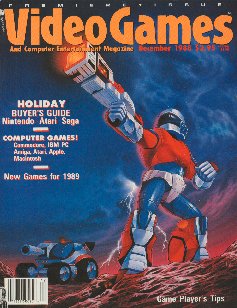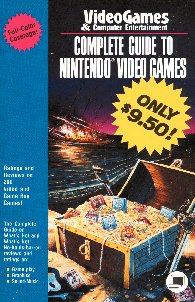|
Part 1: Early Times
tsr: All right, so first off, tell me what you did at VG&CE.
Chris Bieniek:
I started as a freelance writer; I started submitting reviews
in 1989. They bought one of the ones I submitted, and I ended up with a
regular reviewing gig where they would FedEx games to my house and I'd
write about them. That went on until 1992, when I got a full-time job at
the
Beverly Hills offices. I've worked at the same company since then.
tsr:
As VG&CE turned into VideoGames?
CB:
Yeah, then VG&CE turned into VideoGames...
tsr:
'cos that's one thing I definitely want to ask about.
CB:
Like, "What the hell happened?" (laughs) It turned into a real pile of
shit.
tsr:
I'll get to that later, but let's start at the beginning. VideoGames
& Computer Entertainment started in the summer of 88, a little after
Nintendo Power, right?
 |
|
|
A.N.A.L.O.G. Computing, issue 27
|
CB:
Around the same time. VG&CE was a spinoff of A.N.A.L.O.G. Computing,
which was an Atari computer magazine published by the same company, Larry
Flynt Publications. Arnie Katz, Bill Kunkel and Joyce Worley did a monthly
feature for A.N.A.L.O.G. that covered the video game industry, because
the NES had just come out and it was turning into a big deal all over
again. That monthly column was turned into a monthly magazine, and that was
VG&CE.
tsr:
So they went from the old Electronic Games...
CB:
Well, EG lasted until '84 or '85 or so, and eventually changed its name
to Computer Entertainment...but Arnie and those guys left before the
magazine folded. A.N.A.L.O.G. had been started by a different publisher and
was actually a contemporary of EG; it was bought by LFP in the mid-'80s.
Arnie and Joyce and Bill eventually reappeared as contributors to
A.N.A.L.O.G., if I remember correctly.
tsr:
How did you enter VG&CE yourself?
CB:
There was another magazine called Computer... Fun, I think? Maybe
Computer Play? I don't remember the name... anyway, it only lasted 10 or 12
issues, and this was around the time when the NES was getting hot, but
there were no magazines covering it. They ran an ad soliciting reviews from
freelance writers. They had done a couple of NES reviews, and I wanted to
get into that, so I sent some samples.
tsr:
What were the sort of reviews you submitted?
CB:
It was Rad Racer and Legendary Wings...
tsr:
Oh, so that would be '87 by that time.
CB:
Yeah, that was right before I broke in. And they called me up and asked
if I'd be interested in reviewing PC games. I had to lie to them; I told
them I had a PC, but I didn't. Then VG&CE came out and I thought, "Wow!
I'll try them!" Because if I had never seen that ad in the other magazine,
it would have never occurred to me to try to send in submissions to a
magazine.
tsr:
 |
|
VG&CE, issue one, Blaster Master on the cover. The
beginning of a new world of magazines.
|
Did you have experience with writing before?
CB:
Not really. I was just a video game crazy guy who happened to be able
to construct a coherent sentence. Plus, I was real careful - when I saw
that first issue of VG&CE, I paid attention to the format of their reviews.
I sent them the Legendary Wings review I sent to the other mag...and a buddy
of mine had just got Anticipation, you remember that game?
tsr:
Uh-huh.
CB:
He got that for Christmas. I borrowed it, wrote a review of it, and I
did it in the exact format of the way VG&CE published their reviews. And
they bought it! It freaked me out because they didn't print it until the
June or July issue of the following year,1989...that game was already eight
months old! But I got like 75 bucks, and I was stoked because my name was
in the magazine.
tsr:
What was the average pay at the time?
CB:
I think it was 65 bucks at the very beginning; it went up to $75 per
review a few years later. There wasn't any limitation on the word count or
anything, it wasn't very scientific. I would have done it for free, just to
check out games and see my name in the magazine! And after a couple months,
they called me and they sent me a game called The Guardian Legend...
tsr:
Yep.
CB:
I wrote a review of that, and pretty soon they were sending me stuff
regularly. I started getting games in advance of their release, which was the
coolest thing in the world. (laughs)
tsr:
Did you get to keep any of those, or did you have to return them all?
CB:
I tried to keep as many of them as I could! (laughs) If they called me
and said "So and so is bugging us, we have to get that game back", I had to
send it back, but I tried to hold on to them. And of course, when a
position finally opened in 1992 and I flew out to L.A., I got to see where
all that stuff was coming from...and I became kind of protective of the NES
stuff.
See, when VG&CE turned into VideoGames, the guy who took over the magazine
had no interest or knowledge in the NES at all, and he wanted to get rid of
all those games; he thought they were just taking up space! I was grabbing
boxes of them. He just wanted them all out of there. So lemme just say...if
you collect video games and you work for a game magazine, it can kind of
help your collection a lot. (laughs)
tsr:
So you submitted reviews to VG&CE from Anticipation up until '92?
CB:
As a freelance writer, yeah...and after I became Associate Editor, I
continued to do them full-time until '95 or so.
tsr:
And did they give you any guidelines?
CB:
No, I never got any; I just tried to do what they were doing. The
people who started the magazine - Andy Eddy, Clayton Walnum, Lee Pappas and
the regular freelancers who they had - I was just trying to emulate what
they were doing; I was trying to fit in with the "house style." If I turned
in something that looked like they had written it, I figured they wouldn't
have to do a lot of work cleaning it up.
tsr:
Were you mostly reviewing NES games?
CB:
I started out doing NES stuff, but eventually I was doing TurboGrafx,
Genesis and Super NES reviews...then they gave me the monthly portable
gaming column. That kind of helped me get into a full-time position, because
I was reviewing every single Game Boy, Game Gear and Lynx game that came out.
I could contact the companies from my house in Chicago and say "I need to
know when these games are coming out" or "Send me a picture of so and so". It
was very cool. At Christmas time every year I would get to do 4 or 5 games
every issue.
 |
tsr:
Did you do any non-magazine things at the time as well?
CB:
Before I moved out to California, VG&CE did a book called The VideoGames
& Computer Entertainment Complete Guide to Nintendo Video Games; it had
reviews of maybe 200 NES and Game Boy games. The way the book was done was
really shitty, because they had to get all those reviews done in just a few
weeks, so we were just cranking through those games.
tsr:
How big were the reviews?
CB:
Maybe one per page. It was aimed at parents more than kids, really.
tsr:
That was what I wanted to ask about. The aim of most of the mags at
the time was a pretty young audience, and it seemed that VG&CE was
definitely aiming at an older one.
CB:
I don't think they deliberately did that, though. Part of the thing was
that - since it was a spinoff of A.N.A.L.O.G. magazine - those readers were
pretty sophisticated. They were all computer users, they were usually at
least savvy enough to write computer programs. I think when they started
VG&CE, they just kept doing what they were doing at A.N.A.L.O.G. And that
became a factor when VG&CE turned into VideoGames.


|




